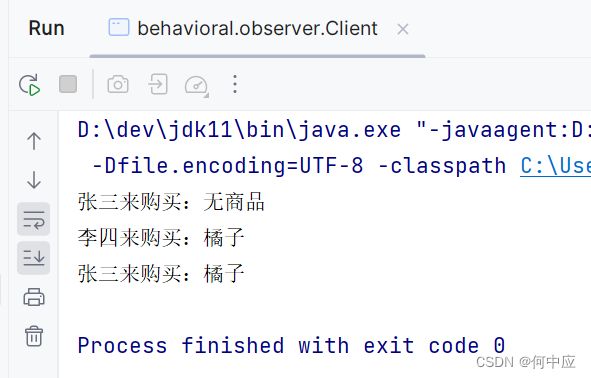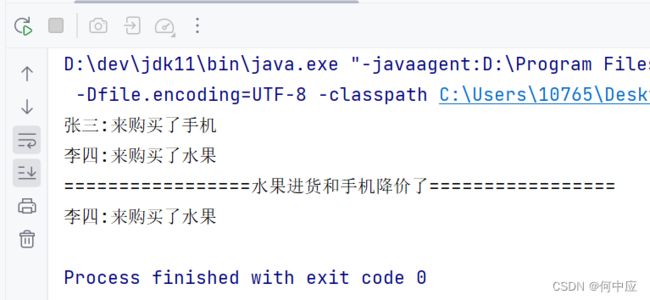【设计模式-4.2】行为型——观察者模式
说明:本文介绍设计模式中行为型设计模式中的,观察者模式;
商家与顾客
观察者模式属于行为型设计模式,关注对象的行为。以商家与顾客为例,商家有商品,顾客来购买商品,如果商家商品卖完了,顾客则购买失败。如下:
(Shop,商家类,提供购买、进货方法)
/**
* 商家
*/
public class Shop {
/**
* 商品
*/
private String product;
public Shop() {
this.product = "无商品";
}
/**
* 出货
* @return
*/
public String getProduct() {
return product;
}
/**
* 进货
* @param product
*/
public void setProduct(String product) {
this.product = product;
}
}
(Buyer,顾客类,注入商店对象,购买商店商品)
/**
* 顾客
*/
public class Buyer {
private String name;
private Shop shop;
public Buyer(String name, Shop shop) {
this.name = name;
this.shop = shop;
}
/**
* 买家购买商品
*/
public void buy() {
System.out.println(name + "来购买:" + shop.getProduct());
}
}
(Client,客户端,演示购买动作)
/**
* 客户端
*/
public class Client {
public static void main(String[] args) {
Shop shop = new Shop();
new Buyer("张三", shop).buy();
shop.setProduct("橘子");
new Buyer("李四", shop).buy();
}
}
(执行结果)
分析上面的行为,可以发现一点缺陷。当商家的商品发生变化时,无法主动的,自发的通知顾客,只有顾客来购买时,才知道商品的信息。因此,我们考虑是否可以在商家类内部维护一个“顾客列表”,当商品信息发生变化时,调用顾客列表中所有顾客对应的方法,达到主动通知客户的目的。如下:
(Shop,商家类,维护一个顾客列表,新增一个通知顾客的方法)
import java.util.ArrayList;
import java.util.List;
/**
* 商家
*/
public class Shop {
/**
* 商品
*/
private String product;
/**
* 顾客列表
*/
private List<Buyer> buyers;
public Shop() {
this.product = "无商品";
this.buyers = new ArrayList<>();
}
/**
* 添加顾客
* @param buyer
*/
public void addBuyer(Buyer buyer) {
this.buyers.add(buyer);
}
/**
* 移除顾客
* @param buyer
*/
public void removeBuyer(Buyer buyer) {
this.buyers.remove(buyer);
}
/**
* 出货
* @return
*/
public String getProduct() {
return product;
}
/**
* 进货
* @param product
*/
public void setProduct(String product) {
this.product = product;
notifyBuyers();
}
/**
* 通知顾客
*/
public void notifyBuyers() {
for (Buyer buyer : buyers) {
buyer.buy(product);
}
}
}
(Buyer,顾客抽象类,创建一个购买商品的抽象方法)
/**
* 顾客
*/
public abstract class Buyer {
/**
* 顾客姓名
*/
protected String name;
public Buyer(String name) {
this.name = name;
}
/**
* 买家购买商品
*/
public abstract void buy(String product);
}
(FruitBuyer,水果买家,只购买水果类的商品)
/**
* 水果买家
*/
public class FruitBuyer extends Buyer{
public FruitBuyer(String name) {
super(name);
}
@Override
public void buy(String product) {
if (product.contains("水果")) {
System.out.println(name + ":来购买了水果");
}
}
}
(PhoneBuyer,手机买家,只购买手机类的商品)
/**
* 手机买家
*/
public class PhoneBuyer extends Buyer{
public PhoneBuyer(String name) {
super(name);
}
@Override
public void buy(String product) {
if (product.contains("手机")) {
System.out.println(name + ":来购买了手机");
}
}
}
(Client,客户端,模拟购买行为,张三只购买手机,买了一次后就不再需要了)
/**
* 客户端
*/
public class Client {
public static void main(String[] args) {
Shop shop = new Shop();
PhoneBuyer phoneBuyer = new PhoneBuyer("张三");
FruitBuyer fruitBuyer = new FruitBuyer("李四");
shop.addBuyer(phoneBuyer);
shop.addBuyer(fruitBuyer);
shop.setProduct("苹果手机");
shop.setProduct("各种水果");
shop.removeBuyer(phoneBuyer);
System.out.println("=================水果和手机降价了=================");
shop.setProduct("水果和手机降价了");
}
}
执行结果。当商家的商品信息有变化时,会通知到对应的顾客来购买。
类比现实生活,小村庄里只有一家商店。我们需要购买某样日用品,去商店购买,店长说没有,下个月才进货。很自然的,我们会和店长说,那我留下电话,进货了打电话通知我。
其中,留下电话,可以类比为将顾客注册到商店类中,而打电话则是调用顾客类对应的方法。
Spring中的体现
观察者模式,是一种订阅-发布的模式。在上面的例子中,商家是发布者,顾客是订阅者,当商家商品信息有变动时,发布信息,顾客接收。
Spring框架中,就有观察者模式的应用。如下:
(Customer,消费者类)
import org.springframework.context.ApplicationEvent;
public class Customer extends ApplicationEvent {
private String message;
public Customer(Object source, String message) {
super(source);
this.message = message;
}
public String getMessage() {
return message;
}
}
(CustomListener1,消费者1号)
import org.springframework.context.ApplicationListener;
import org.springframework.stereotype.Component;
@Component
public class CustomListener1 implements ApplicationListener<Customer> {
@Override
public void onApplicationEvent(Customer customer) {
System.out.println("1号订阅者收到消息: " + customer.getMessage());
}
}
(CustomListener2,消费者2号)
import org.springframework.context.ApplicationListener;
import org.springframework.stereotype.Component;
@Component
public class CustomListener2 implements ApplicationListener<Customer> {
@Override
public void onApplicationEvent(Customer customer) {
System.out.println("2号订阅者收到消息: " + customer.getMessage());
}
}
(Publisher,发布者)
import org.springframework.beans.factory.annotation.Autowired;
import org.springframework.context.ApplicationEventPublisher;
import org.springframework.stereotype.Component;
@Component
public class Publisher {
@Autowired
private ApplicationEventPublisher eventPublisher;
public void publishCustomEvent(String message) {
eventPublisher.publishEvent(new Customer(this, message));
}
}
(在测试类中,发布信息)
import org.junit.Test;
import org.junit.runner.RunWith;
import org.springframework.beans.factory.annotation.Autowired;
import org.springframework.boot.test.context.SpringBootTest;
import org.springframework.test.context.junit4.SpringRunner;
@SpringBootTest
@RunWith(SpringRunner.class)
public class PublisherTest {
@Autowired
private Publisher publisher;
@Test
public void test1() {
publisher.publishCustomEvent("Hello World!");
}
}
执行结果,2个订阅者都收到了消息;
以上就是观察者模式的实现;
总结
本文参考《设计模式的艺术》、《秒懂设计模式》两书


